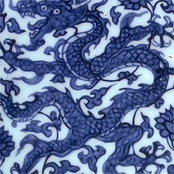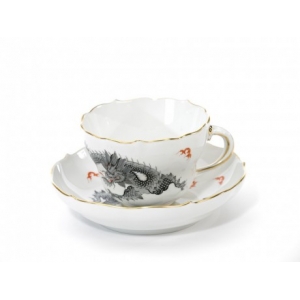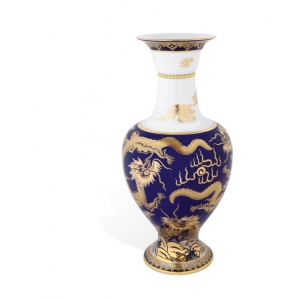Ming Dragon
The image of the mythological dragon in the style of the Chinese masters of painting on porcelain of the Ming-dynasty (1368-1644) is at the basis of this pattern, which has been known to collectors since the 1740s.

This period in the development of Chinese porcelain art is very famous for its style of painting. For the first time, polychrome overglaze colors were used, which allowed beautiful artworks to take over from normal geometric patterns that were common before. This led to a tremendous increase in the used themes, which become increasingly complex. The main motives used were fishes, animals, dragons, and flowers, but also images of people, children and mythical creatures with small details were used.

Vases from the Ming dynasty are precious because in the first place they comply entirely with the highest quality standards of porcelain: the blue color and the clear, thin and transparent material. The perfection of the forms and the unique beauty of the painting made these creations unique. One of the characteristics of the painting of the Ming dynasty vases was the underglaze cobalt painting, which had a blue color. The vessels were painted with different shades of this color: from gray-blue to bright blue.

Europe’s acquaintance with the Oriental porcelain led to massive imitating and copying of the technologies, themes and colors of the paintings. Also the Meissen manufacture was not an exception in this regard and pursued a pursuit of fashion of the time.
Ming dragons, based on a mythological theme, became one of the variations of Chinese decoration and received incredible recognition. The dragon even often symbolized the Emperor himself in the Chinese painting. Now, the dragon has found a second life and is one of the most elegant patters to be found in Meissen products.
.jpg)
The Chinese dragon has long nails, his head is crowned with horns, his body is covered with scales, and he has sharp teeth. As a rule, the dragon is depicted with a pearl, like a luminous sphere, which he either swallows or spews from his mouth. On the Meissen products, the dragon is depicted while he is trying to catch the pearl. It is exactly in this pearl that the all energy and strength of this beast is hidden. It symbolizes wealth and power. The dragon himself is symbol for power, wisdom, spirit of change, the rhythm of nature, sun, and masculinity. In some cases, two dragons are depicted facing each other, in which case they represent yang (strength, heaven) and ying (force, land).
Until the 20th century, only Emperors could order tableware with red dragons, but currently they are available to all lovers of Meissen porcelain. This tableware series has a huge number of items and can be ordered in eighth different colors: black, blue, green, purple, red, violet, yellow, and brown.





